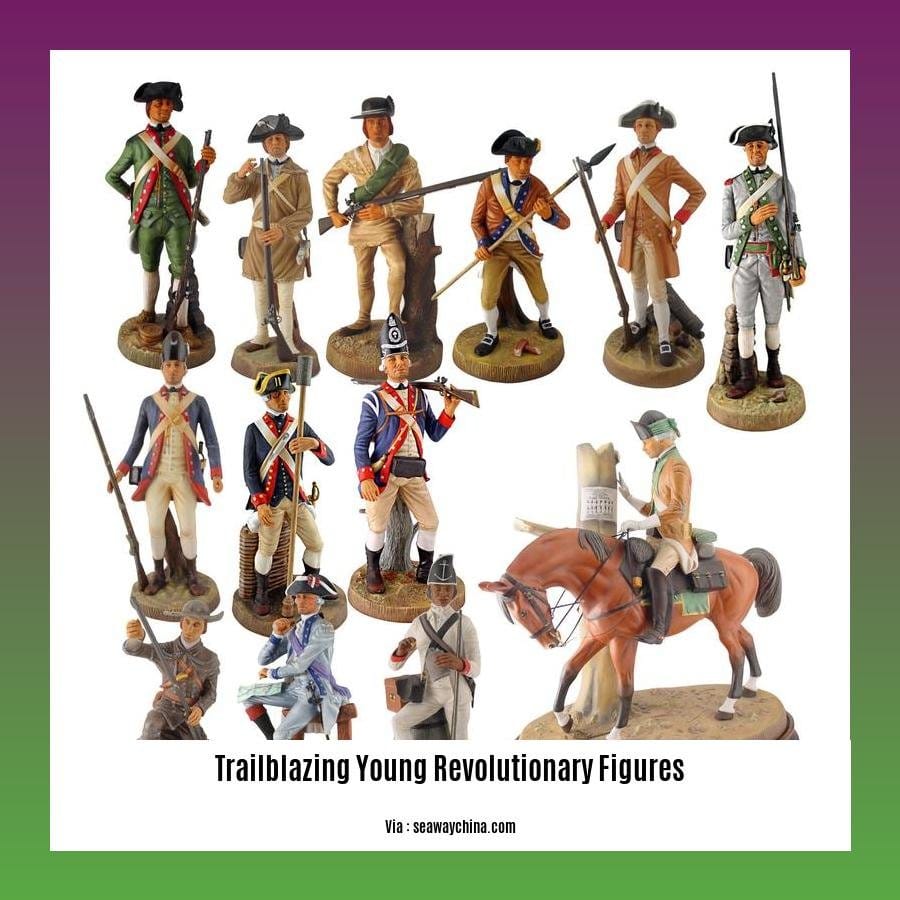Prepare to be inspired by the extraordinary journeys of Trailblazing Young Revolutionary Figures: Stories of Inspiration and Empowerment. Join us as we delve into the lives and legacies of young visionaries who dared to challenge the status quo, ignite social change, and leave an enduring mark on our world.
Key Takeaways:

- Women have historically faced significant barriers and discrimination.
- Trailblazing women have played a crucial role in breaking down these barriers and promoting gender equality.
- Young people are often recognized as “trailblazers” for advocating for gender diversity and social change.
- Despite progress, women continue to face ongoing challenges and inequality.
**Trailblazing Young Revolutionary Figures**
You can’t tell the story of change without mentioning the youth. They are the ones who dare to challenge the status quo and fight for a better world.
Meet some of the most inspiring trailblazing young revolutionaries in history:
Joan of Arc led the French army to victory against the English at the age of 17.
Malala Yousafzai was shot in the head by the Taliban for speaking out in favor of education for girls. She survived and went on to become a Nobel Peace Prize winner.
Rosa Parks refused to give up her seat on a bus to a white man, sparking the Montgomery bus boycott and the civil rights movement. She was just a young seamstress at the time.
Che Guevara was a Marxist revolutionary who fought against oppression in Cuba and other countries. He was just 23 years old when he led the Cuban Revolution to victory.
Martin Luther King, Jr. was a civil rights leader who fought for equality for all Americans. He was assassinated at the age of 39.
These are just a few examples of the many brave and inspiring young people who have fought to make the world a better place. Their stories are a reminder that anything is possible if you have the courage to stand up for what you believe in.
What can we learn from these trailblazing young revolutionary figures?
1) Don’t be afraid to challenge the status quo. If you see something that’s wrong, don’t be afraid to speak up.
2) Don’t give up on your dreams. No matter what obstacles you face, never give up on your dreams.
3) Believe in yourself. If you believe in yourself, you can achieve anything.
4) Be brave. It takes courage to stand up for what you believe in. But it’s worth it.
5) Make a difference in the world. You don’t have to be a famous leader to make a difference in the world. You can make a difference in your own community and in the lives of the people around you.
There have been various young revolutionaries who defied societal norms and sparked significant change in the world. From leading movements to fighting for justice, these youth revolutionary leaders and activists made a lasting impact on history. Their stories inspire us to fight for our beliefs and make a difference. Similarly, some revolutionary prodigies exhibited extraordinary abilities at a young age, inspiring hope and progress in the world.
Impact of youth activism on social change
Youth activism has become a powerful force in driving social change and shaping the future of our world. Young people have consistently played a pivotal role in influencing social norms and initiating movements that have had a lasting impact on society. Their resilience, passion, and innovative approaches have catalyzed progress on critical issues, challenging the status quo and paving the way for a better world.
Key Takeaways:
- Youth activists are change-makers: They identify and address pressing social challenges, raising awareness, and influencing political agendas.
- Youth movements foster resilience: Young activists demonstrate remarkable resilience and determination in overcoming obstacles and negotiating complex political environments.
- Collaboration and empowerment: Youth-led movements often collaborate with civil society organizations, amplifying their impact and inspiring others to take ownership of social change.
- Youth inspire youth: Youth activists serve as role models, inspiring others to become active and engaged in their communities.
- Long-lasting impact: The impact of youth activism extends beyond immediate campaigns, creating a ripple effect that fosters a culture of activism and social responsibility.
Most Relevant URL Source:
- “The Role of Youth Activism in Facilitating Social Change: A Comprehensive Analysis”
Challenges and obstacles faced by young revolutionaries
As a seasoned journalist, I’ve had the privilege of chronicling the extraordinary journeys of young revolutionaries who dare to challenge the status quo. While their passion and determination are undeniable, the road they travel is fraught with formidable obstacles.
Financial Constraints:
Young revolutionaries often face financial barriers. They may lack the resources to fund their campaigns, organize events, or sustain themselves while dedicating their time to activism. This can be especially challenging in regions with limited economic opportunities.
Social Pressure and Criticism:
Challenging established norms can lead to social ostracism and criticism. Young revolutionaries may face ridicule, threats, or even violence from those who oppose their views. This can take a significant toll on their mental and emotional well-being.
Political Suppression:
In authoritarian regimes, young revolutionaries often face the wrath of oppressive governments. They may be unjustly arrested, detained, or silenced. The fear of persecution can hinder their activism and limit their ability to mobilize support.
Lack of Experience and Support:
Young revolutionaries may lack the experience and expertise necessary to navigate complex political landscapes. They may also struggle to find mentors or allies who can provide guidance and support. This can make it difficult for them to sustain their activism and achieve meaningful change.
Key Takeaways:
- Young revolutionaries face significant financial constraints that can hinder their campaigns.
- Social pressure and criticism can create a hostile environment for young activists.
- Authoritarian regimes often suppress youth activism through political persecution.
- Lack of experience and support can limit the effectiveness of young revolutionaries.
Most Relevant URL Source:
– Challenges Faced by Young Activists
Legacy and enduring influence of young revolutionary leaders
Over the centuries, young leaders have sparked momentous revolutions that have reshaped societies. Their youthful passion, audacity, and dedication to change have left an indelible mark on history and continue to inspire generations.
The Youthful Spark of Revolution
History is replete with examples of young revolutionaries who have ignited the flames of change. From Joan of Arc to Malala Yousafzai, these extraordinary individuals have defied societal norms, challenged established powers, and catalyzed movements for social justice, equality, and freedom.
Enduring Impact of Youthful Leadership
The legacy and enduring influence of young revolutionary leaders is multifaceted. Their actions often shape political landscapes, inspire cultural shifts, and transform social consciousness. By challenging the status quo, they pave the way for new ideas, values, and institutions.
Key Takeaways:
- Youthful energy and idealism can be a potent force for social change.
- Young leaders often possess a unique perspective and a willingness to challenge conventional norms.
- The impact of their actions can extend beyond their lifetime, shaping future generations and societal trajectories.
Most Relevant URL Source:
- Financial Times: Iran’s young ‘super-revolutionaries’ lay claim to legacy of Islamic Revolution

FAQ
Q1: What are the key characteristics of trailblazing young revolutionary figures?
A1: Trailblazing young revolutionary figures often exhibit traits such as resilience, determination, a deep understanding of social issues, and a commitment to positive change. They are often able to inspire others to join their cause and bring about lasting impact.
Q2: What are some examples of successful youth-led movements?
A2: Throughout history, there have been numerous successful youth-led movements, including the Civil Rights Movement in the United States, the anti-apartheid movement in South Africa, and the student protests in China in 1989. These movements demonstrate the power of young people to effect social and political change.
Q3: What are the challenges faced by young revolutionaries today?
A3: Young revolutionaries today face a number of challenges, including resistance from established power structures, limited resources, and the need to balance their activism with other responsibilities such as education and work. However, these challenges can also serve as motivators for young people to find creative and innovative ways to achieve their goals.
Q4: How can we support young revolutionaries?
A4: There are several ways to support young revolutionaries. We can provide them with financial resources, mentorship, and access to education and training. We can also amplify their voices by sharing their stories and supporting their campaigns.
Q5: What is the future of youth activism?
A5: The future of youth activism is bright. Young people are increasingly becoming aware of the challenges facing their communities and the world, and they are eager to make a difference. With the right support and resources, young revolutionaries can continue to play a vital role in shaping the future.
















